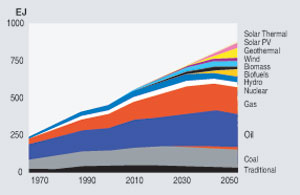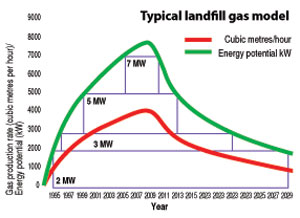Sunday Times 2
Benefits of electricity generation utilising waste management
View(s):Excerpts from a presentation made by B.R.O. Fernando, Past President of the Institution of Engineers Sri Lanka (IESL) and a former Vice Chairman of the Ceylon Electricity Board on Challenges and Opportunities in the Use of Renewable Energy at IESL and the British Council after attending a workshop on renewable energy organized by the World Renewable Energy Council in UK
Growing evidence has convinced most of the scientific community that some degree of climate change has taken place. This climate change is due to a small glitch in the sun’s output of energy or due to the activities of human kind or both. But the media and everyone else slip easily into the use of phrases like “greenhouse gases”and global warming.”
 The greenhouse effect of carbon dioxide and other gases present in the atmosphere has shown an increasing number of signs that the nature of the earth’s surface is beginning to change. The discussions held at Kyoto and Johannesburg have increased the awareness of renewable energy.It is worth mentioning that if we compare the emissions from electrical power plants we find that using coal or oil to generate produces 1110 gm of CO2 /KWH. Using gas reduces CO2 to 600 gm/KWH and biomass reduces CO2 dramatically to 16 gm/KWH. ((Ref: World Renewable Energy Congress 2002).
The greenhouse effect of carbon dioxide and other gases present in the atmosphere has shown an increasing number of signs that the nature of the earth’s surface is beginning to change. The discussions held at Kyoto and Johannesburg have increased the awareness of renewable energy.It is worth mentioning that if we compare the emissions from electrical power plants we find that using coal or oil to generate produces 1110 gm of CO2 /KWH. Using gas reduces CO2 to 600 gm/KWH and biomass reduces CO2 dramatically to 16 gm/KWH. ((Ref: World Renewable Energy Congress 2002).
The Meethotamulla garbage dump has raised and resulted in a hornets nest of insurmountable and unaccountable proportions, resulting in the loss of life to 32 innocent people and 30 missing persons followed by the devastation of their homes and livelihood. These poor people’s agony and disgust at living in an area inhaling an agonising smell with an unhygienic environment full of toxic gases, insects, worms and flies was not the general concern nor was it brought to the attention of some politicians of successive governments and health authorities for nearly two decades. This devastation of their livelihood was a blessing in disguise as it has now resulted in immediate measures to inspect and control the management of other garbage dumps around the country, and provided a planned scientific method for waste management techniques using landfills.
Biomass industries are an asset to any country where energy is generated from waste. A wide range of technological pathways are available, ranging from domestic open fires to bio-fermentation processes for the treatment of organic wastes of a community, to fully commercial complex thermo chemical reactors in the form of 100MW combined heat and power stations. Waste from municipal and industrial services represents an increasingly important fuel source that can be used to produce heat and power. Using these wastes as fuel can have important environmental benefits. Methane is a very potent greenhouse gas, 21 times more damaging than carbon dioxide emissions through displacement of fossil fuels produced by biodegradable waste and residue. When diverted to a landfill, gas is collected and used as a fuel (rather than allowed to escape in to the atmosphere, thus avoiding methane emissions). Contributions made at various forums look optimistically at renewable energy technologies of both those that are well established and those that are still a long way from making a commercial impact. Wind power, passive and electronic solar energy and certain new methods in the use of biomass have moved into the normal commercial world. Technologies such as waves, ocean, thermal and tidal energy and the hydrogen economy have not, as yet; but the prospects are still good and the potential benefits are enormous.
 Biomass industries Energyfrom waste
Biomass industries Energyfrom waste
Biomass includes a wide range of chemically stored solar energy resources originating from plant material. Conversion into useful energy services and products can be undertaken using a wide range of technological pathways. Biomass products can vary in scale from simple combustion to domestic open fires to bio fermentation processes for the treatment of organic wastes of a community, to a fully commercial complex thermo chemical reactor in the form of 100 MW combined heat and power station.
Traditional biomass currently contributes from 12 to 13% of global primary energy demand, but is based mainly in the non-sustainable annual burning of 2×109 tonnes of firewood, 1.3×109 tonnes of crop residue and 1×109 tonnes of animal dung. Removal of this material from the land, robs the soil of recycled nutrients, exposes it to wind erosion, reduces the organic matter content and reduces the soil rooting depth. There are generic environmental issues relating to the biomass base. USA has fallen behind much of the world in the use of biomass and other renewable energy forms to produce electricity and steam. Instead USA embraced coal for energy production. Currently over 52% of US power is fueled by coal. CO2 emissions for US coal fired plants are estimated to be 2.3 million tonnes per year. The CO2 output of USA has increased by 20% since 1990 and millions of tons of sulphur in the form of SO2 and SO3 are emitted every year. Wastes from municipal and industrial services represent an increasingly important fuel source that can be used to provide heat and power. These types of waste are produced worldwide wherever there are centres of population. Using these wastes as fuels can have important environmental benefits. It can provide a safe and cost effective disposal option for wastes that could otherwise pose significant disposal problems. The use of waste as a fuel helps to reduce carbon dioxide emissions through the displacement of fossil fuels.
Any energy that is recovered from biodegradable waste can be regarded as renewable energy. It comes from carbon dioxide in the atmosphere. When the biomass material is used as a fuel, the CO2 is returned to the atmosphere in a “carbon neutral” cycle, and the biomass is used to displace fossil fuels. Instead of being left to decompose naturally, it will actually help to limit the emission of CO2 and methane to the air.There are many ways of combining waste disposal with energy recovery. The UK’s landfill gas industry is today one of the most developed in the world. For the last 45 years landfill gas has provided UK companies the ability to convert a potential hazard into a source of renewable energy. As the industrialised nations move towards reducing emissions to the atmosphere in an effort to stem global warming, landfill gas is fast becoming one of the chief areas of activity for developers, providing as has been proved in the UK, a low cost, reliable baseload with clear environmental benefits. During the past few years a capacity of more than 600MW of landfill gas has been commissioned.
Biomass resources converted to bio energy through technology routes
(Heat, power or transport fuels) Landfill gas
 Energy can also be recovered from waste that had already been landfilled in the form of landfill gas (also referred to as biogas). In the process of anaerobic bacteria break down the organic fraction of the landfill in the absence of air, generates a mixture of gases comprising mainly methane, carbon dioxide, oxygen, nitrogen and many hundreds of trace compounds of gases as well as water vapor and waste products. The biogas can be collected by drilling wells into the waste and extracting it as it is formed. After cleaning, it can be used in an engine or turbine for power generation, or used to provide heat for industrial purposes such as brickworks situated near the landfill site. Landfill sites can develop commercial quantities of “landfill gas” for up to 30 years after the waste has been deposited. The graph given above is a graphical representation of landfill gas and energy availability against time. The gas is normally collected from a series of vertical boreholes that have been purpose drilled in to the site.
Energy can also be recovered from waste that had already been landfilled in the form of landfill gas (also referred to as biogas). In the process of anaerobic bacteria break down the organic fraction of the landfill in the absence of air, generates a mixture of gases comprising mainly methane, carbon dioxide, oxygen, nitrogen and many hundreds of trace compounds of gases as well as water vapor and waste products. The biogas can be collected by drilling wells into the waste and extracting it as it is formed. After cleaning, it can be used in an engine or turbine for power generation, or used to provide heat for industrial purposes such as brickworks situated near the landfill site. Landfill sites can develop commercial quantities of “landfill gas” for up to 30 years after the waste has been deposited. The graph given above is a graphical representation of landfill gas and energy availability against time. The gas is normally collected from a series of vertical boreholes that have been purpose drilled in to the site.
As mentioned earlier, methane has a greenhouse gas potential of approximately 21 times that of carbon dioxide and although methane is eventually oxidized in to the atmosphere, the uncontrolled release of landfill gas contributes significantly in emissions of greenhouse gas and thus global warming The International Panel on Climate Change (IPCC) estimated that landfill gas contributed to between 20 million tonnes and 70 million tonnes of methane in the atmosphere in 1990. Estimated emissions of methane from solid waste disposal within the 15 European Union countries rose from 7,233,000 tonnes in 1994 representing the largest single source of methane and around 33% of the total, in the EU. Removal of methane emissions and conversion to carbon dioxide, provides a valuable contribution to the reduction of greenhouse gas emissions. A typical 1MW landfill gas project will reduce gas emissions by around 30,000 tonnes an year.
Anaerobic digestion
The biological processes that take place in a landfill site can be harnessed in a specially designed vessel known as an anaerobic digester, to accelerate the decomposition of wastes. Anaerobic digestion is typically used on wet waste such as sewerage, sludge or animal slurries. But the biodegradable fraction of municipal wastes can be added to wetter wastes to increase the biogas output.
The rapidly expanding functions of the renewable sector worldwide is comparable to that of the oil and gas sectors in the early 1970s.The positive roll continues today. The experience gained after 45 years, in oil and gas will undoubtedly continue to the development of renewables. As part of the climate change strategy most countries the world over have established their targets for the renewables obligation of 10% of the total electricity supply, by the year 2010 recognising the renewable’s contribution to the reduction of CO2 emissions.(However Sri Lanka failed to comply with this.) This was achieved by the requirement placed on electricity supply companies to source an increasing proportion of their supply from “green energy.” Companies that have failed to do this, have the option of buying out their “obligation” at an initial US$42.5/MWH, such monies when paid are distributed among the companies that did meet the obligation.
In such a scenario, wind power will be an obvious winner offering as it does rapid deployment of electricity generating plant at the lowest prices, anywhere in the European Union. Wind power is a technology that has wide support especially in the UK, with off shore and on shore wind which are most strongly supported. Energy from waste makes up a useful part of an integrated waste management system. Furthermore, renewable and greenhouse reduction targets require the exploitation and support of all available clear technologies. Landfill gas clearly offers large potential for the development of projects in countries where carbon certification will provide a degree of financial support for the investment required. The Sri Lankan government should take immediate steps on this vital issue as tonnes of waste are deposited daily in various parts of the country, which is indeed an environmental and health hazard. The present Government should immediately initiate industries in various parts of the country where garbage dumps are in existence to generate electricity, recycle the waste and produce composts as fertilisers and also to earn valuable foreign exchange from carbon certification by generating electricity.
I wish to conclude by drawing attention to a document produced in April 2002 by the National Energy Laboratory in Colorado and operated by the US Department of Energy by Midway Research Institute, wherein the advances made from 1977 to 2002 after 45 years of research excellence are given with the predicted performances in 2020 for bio energy, solar and wind energies.

